Improving the Physical and Chemical Properties of Ibuprofen
The common crystal form of ibuprofen was changed to optimize processing and manufacturing properties. Six modified crystal forms were prepared and assessed for dissolution, morphology, particle size, density, thermal characteristics, powder x-ray diffractometry, flow properties, and tabletability.
Ibuprofen, 2-(4-isobutylphenyl)-propionic acid, is a nonsteroidal drug that is widely used as an anti-inflammatory analgesic and has been a nonprescription drug since 1984. It is slightly soluble in water and has poor flow and compaction characteristics owing to its needle-like (acicular) crystalline structure and viscoelastic properties, respectively (1). Ibuprofen is prescribed in high doses (200–600 mg), which precludes its direct-compression manufacture into suitable-sized tablets. A crystal change of ibuprofen's fine cohesive crystals into more spherical particles that possess better compressibility generally improves its processing into tablet and capsule forms. Drug particles with optimized properties suitable for processing in solid dosage forms are generally prepared by developing suitable individual crystals or by spherical crystal agglomeration.
Background
Udupa reported on the characterization of different crystals of ibuprofen prepared from various solvents (e.g., propylene glycol, acetone, ethanol, and chloroform) (2). The author concluded that the solvents and methods of microprecipitation used affect the properties of the crystal forms. Labhasetwart et al. reported on the preparation and characterization of some crystalline forms of ibuprofen (3). They observed that the drug converted into different crystal forms according to the solvent and method of crystallization, characterized by substantial different dissolution profiles.
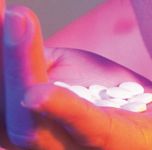
In their study, Khan and Jiabi observed that ibuprofen crystalline forms prepared using a precipitation method in which ethanol and acetone were solvents had the smallest particle size, exhibited circular and plate-like shapes, and had higher dissolution rates. Those prepared with poly(ethylene glycol) and 2-propranol were of intermediate size and had flattened plate- and rod-like shapes. Crystal forms prepared by cooling hot solution of ibuprofen in ether were of larger size with irregular and rectangular plate-like shape and had lower dissolution rates (4).
Nikolakakis et al. investigated the relationship between crystallization conditions and micromeritic properties of ibuprofen. Results indicated that higher crystal yield and crystal growth could be achieved with fast cooling rates using methanol as a solvent. The shape and surface of individual crystals were significantly affected by the polarity of the solvent as a result of interactions with growing crystal (5).
Garekani et al. reported on the crystal habit modifications of ibuprofen and their physicomechanical characteristics. Results indicated that crystal habit modification significantly influenced the mechanical properties of ibuprofen (e.g., compressibility, flowability, and bulk density). In addition, samples obtained from methanol and ethanol exhibited the highest bulk density and best flow (6).
Rasenack and Mueller reported on the preparation of ibuprofen crystal with optimum tableting behavior (7–9). The authors proposed a new parameter (Tfactor) as a good indicator for tabletability, including crushing strength and other relevant components such as percent of plastic energy, total energy consumption, and upper-punch force (8).
Kachriamanis et al. studied the spherical crystallization of ibuprofen using a solvent mixture of ethanol and water in the presence of Eudragit S100. They concluded that slow cooling enhances the stirring-rate effect on particle-size growth and sphericity. Furthermore, the particle size decreased, and sphericity and surface roughness and interparticle porosity increased by increasing polymer concentration (10).
The study described in this article investigated simple methods to achieve optimum crystal properties of ibuprofen raw material that are potentially suited for producing tablets and capsules. These methods include crystallization of the drug from ethanol and ethanol–water systems in the absence and presence of some organic and inorganic additives under various conditions. Changes in drug-crystal properties are evaluated for dissolution rate, particle size and surface characteristics, density, flow properties, crystal modification, and polymorphic changes as well as compaction and tableting properties.
Materials and methods
Materials. Ibuprofen (lot LPL-6761, Malinckrodt, USA; courtesy of KSPICO, Kuwait), ethanol (BDH, Poole, UK), gelatin (Gainland Chem. Co., Flintshire, UK), Aerosil 300 (Degussa, Darmstadt, Germany). All other chemicals were of analytical grade.
Crystallization techniques. Six different modified particles of ibuprofen raw material were prepared and denoted as Ib1–Ib6. In all crystallization experiments, 40 g ibuprofen were dissolved in 40 mL ethanol at 40 °C. For Ib1, an additional 20 g of ibuprofen drug powder were added to the hot ethanolic drug solution, then stirred with a magnetic stirrer for 1 h at room temperature and set aside overnight at ambient temperature. For Ib2, 40 g of ibuprofen and 40 mL ethanol were dissolved at 40 °C, then slowly crystallized at room temperature. Ib3 was prepared by dissolving 40 g of drug and 40 mL of ethanol at 40 °C, then inducing a crystallization process by gradually adding 400 mL of cold water (5 °C) over 20 min under continuous stirring. Ib4–Ib6 were prepared in the same manner as Ib3, except cold water was replaced with phosphate buffer pH 8, 0.5% gelatin, and 0.1% Aerosil, respectively. The separated materials were filtered off and washed with four successive portions of cold water (25 mL each). The purity of the drug and absence of residual crystallization additives in various modifications were assessed by UV spectrophotometry at 220 nm. The dried material was sieved, and fractions >150 μm were used in all experiments. For the dissolution study, only the 75–150 μm fractions were used, except in the case of the control (Ib) samples in which the powder was used as supplied. All modifications were kept after drying in a desiccator.
Characterization methods
Surface characteristics and morphology. Characterization of the particle shape and surface was conducted using scanning electron microscopy (SEM) (JSM 3600, Jeol, Japan).
Particle-size analysis. Particle-size distribution was determined with a laser diffractometer (Helos KFS Rodos, Sympatec GmbH, Clausthal, Zellerfeld, Germany).
Density determination. To determine the poured-bulk (fluff) and consolidated-bulk (tapped) densities, 20 g of each sample were transferred to a graduated cylinder. The volume was recorded before and after mechanical tapping for 1250 strokes (model JEL ST2, J. Engelsman, Ludwigshafen, Germany). Using the obtained values, the packing behavior was evaluated and expressed as a Carr's index and a Hausner ratio. The true density was determined with a helium gas pycnometer (AccuPyc 1330, Micromeritics Instrument Corp., Norcross, GA).
Flow properties. Flowability of the powder samples was tested by determining the angle of repose using a constant height (2 cm) and by measuring the hopper flow rate (Erweka Granulate & Powder Tester GTL, Erweka GmbH, Heusenstamm, Germany). The flow index of cohesion of the powder samples also was evaluated using powder rheometry (texture analyzer TAXTplus, Stable Micro Systems, Surrey, UK).
Differential scanning calorimetry (DSC). Thermal characteristics of the samples were evaluated using a Labsys DTA-DSC analyzer (Setaram, Caluire, France). The instrument was calibrated using indium (melting peak = 157 °C) before the experiments were carried out. The heating rate was 10 °C/min, and the sample was contained in aluminum pans under a nitrogen atmosphere. The heat onsets and endsets and the enthalpy of melting were evaluated with Setaram Setsoft software.
Powder x-ray diffraction (PXRD). PXRD patterns were collected in transmission using an x-ray diffractometer (Stoe, PSD supply unit, Darmstadt, Germany) with Cu Kα1 radiation (germanium monochrometer) generated at 30 mA and 40 kV. Powder was packed into the rotating sample holder between two poly(ethylene terephthalate) films.
Wettability. The wetting tendencies of the compressed nondisintegrating disks of each of the modified powders (Ib1–Ib6) and of the raw ibuprofen sample were evaluated by measuring the contact angle according to the sessile drop technique (Geniometer G1, Kruess GmbH, Hamburg, Germany). Disks containing 300 mg of each powder sample were compressed at 40 kN for 90 s. The contact angle between the disk and a drop of saturated aqueous solution of ibuprofen was measured 10 and 60 s after putting each drop onto the disk. Each experiment was run in triplicate.
Dissolution profile. Samples of the ibuprofen starting material and its modified forms (Ib1–Ib6) were subjected to dissolution testing (DT 80, Erweka, Heusenstamm, Germany) according to the USP 25 rotating paddle method in 900 mL of distilled water at 37 °C. Samples were taken at predetermined intervals and assayed for drug content spectrophotometrically at 220 nm (UV-3101PC scanning spectrophotometer, Shimadzu, Kyoto, Japan). All experiments were run in triplicate.
Evaluation of powder tabletability. An instrumented Fette Exacta 11 (Wilhelm Fette Inc., Schwarzenbeck, Germany) single-punch press equipped with a 12-mm flat punch was set at the same adjustment throughout the tabletability evaluation of all powders. Relevant parameters such as punch force, total energy, and energy consumed in plastic deformation and displacement value were recorded (piezoelectric, responsive inductive). Each sample was tested at least in triplicate. The crushing strength of the resulting tablets was subsequently determined (PTB300, Pharma Test, Frankfurt, Germany). The data of compression and mechanical properties of the compacts were applied for estimation of a tabletability parameter (Tfactor), as demonstrated by Rasenack and Mueller (8), according to the following:
Tfactor = plastic deformation × energytotal × (Fc ÷ Fmax) × SFmax (up) × e
in which energytotal is the total energy consumed for both plastic and elastic deformation (Nm), Fc is the crushing strength (N), Fmax is the maximum upper punch force (kN), SFmax (up) is the displacement of the upper punch (mm) at Fmax, and e is the true volume tableted (cm3).
Results and discussion
Preparation and treatment of modified ibuprofen crystals. Ib1 was prepared by crystallization of ibuprofen from ethanolic solution in the presence of raw ibuprofen crystals. During this process, a paste-like mass formed because of a bridging of the initial ibuprofen crystals, which followed the crystallization of dissolved drug after the ethanol had evaporated. The formed lump was dried and sieved to coarse agglomerated crystals to allow fair comparison with other modifications of fractions >150 μm.
For Ib2, the product was separated as big plates after the slow evaporation of ethanol at ambient temperature. The mass was further dried, crushed, and sieved to collect particles >150 μm for further experimentation and comparison with other modifications. This method of crystallization offered enough time for crystal growth and building up of such big and dense plates.
For subsequent modifications, crystallization was induced rapidly under the effect of a simultaneous change of temperature and solvent, in which the cold aqueous phase was added to the hot drug–ethanol solution. The products formed after such treatments appeared as big agglomerates as a result of the simultaneous nucleation and coprecipitation of the drug and additives. After the aggregated particles were separated, the mass was washed with four successive portions of cold water (25 mL each) to elute the remaining amount of additives. Complete removal of additives by the adopted washing technique was evidenced by drug analysis in the various crystal modifications. The material then was dried in a desiccator under vacuum. Finally, particles >150 μm were collected for subsequent experiments, except the dissolution studies for which 75–150 μm fractions were used.
Particle size, shape, and surface characteristics. The crystal modification techniques produced drug particles (Ib1–Ib6) with large differences in shape and size compared with the starting material (see Figure 1). The untreated ibuprofen (see Figure 1a) appeared as fine acicular crystals with high cohesion tendency, which is reflected in its obvious poor flow. The SEM of Ib1 shows that the majority of the crystals agglomerated rather than remain as individual crystals (see Figure 1b).
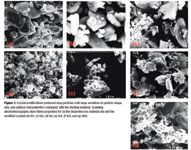
Figure 1: Crystal modifications produced drug particles with large variations in particle shape, size, and surface characteristics compared with the starting material. Scanning electromicrographs show these properties for (a) the ibuprofen raw material (Ib) and the modified crystals (b) Ib1, (c) Ib2, (d) Ib3, (e) Ib4, (f) Ib5, and (g) (Ib6).
In the case of Ib2, this crystallization method allowed enough time for crystal growth and the construction of initial big plates, which basically are formed of plate-like microcrystals (see Figure 1c). For subsequent modifications (Ib3–Ib6), the crystallization method produced spherical agglomerations of ibuprofen into rounded drug particles (see Figure 1d–1g) with relatively smaller bulk densities compared with the first two modified particles obtained without additives (see Table I). This can be explained by the presence of fine intraparticular spaces following additive washing. Although one might expect to see little difference in the micrographs of the untreated and modified forms of ibuprofen, this is not the case. The acicular crystals of the starting ibuprofen material are present in an individual state, whereas in the modifications, crystal aggregates are prevalent. In addition, the starting ibuprofen crystals are adjacent or over each other, rather than in aggregates. This observation was confirmed using laser diffractometric analysis, which revealed a significant change in particle size, and by a significant change in flow properties of the modified crystals compared with that of the control ibuprofen (see Table I). Particle-size results were based on data generated from laser particle-size analysis, which provided a more quantitative and reliable assessment of particle size. SEM was used mainly to illustrate changes in particle morphology.
The effect of the crystallization techniques on crystal growth and increased particle size also was obvious in the results of particle size analysis by laser diffractometry (figures not shown). Taking X90 (90% undersize of the particles) as a parameter for comparing the particle size of the samples, we observed an extensive increase of crystal size amounting to ~850 μm, in comparison with 55 μm for the starting ibuprofen. The relatively smaller value observed for Ib2 is a result of crushing the hard and big plate-like mass left after evaporation of ethanol, thereby forming fine particles.
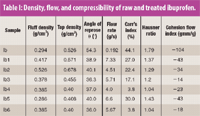
Table I: Density, flow, and compressibility of raw and treated ibuprofen.
Differential scanning calorimetry and powder x-ray diffractometry. Thermal analysis of the modified ibuprofen samples indicated that they are isomorphic with the starting material. Thermograph patterns for the ibuprofen and the prepared crystal modifications were similar; all showed sharp melting peaks (see Table II). The modified samples had an observed mean melting peak of 75.71 ± 0.138 °C and an average mean enthalpy of melting of 128.63 ± 11.6 J/g, compared with 76.01 °C and 127.722 J/g for ibuprofen. This result is in agreement with previous reports indicating that ibuprofen exists as a stable crystalline solid exhibiting a typical melting range of 75–77 °C (11).
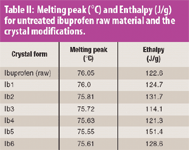
Table II: Melting peak (°C) and Enthalpy (J/g) for untreated ibuprofen raw material and the crystal modifications.
Studies also have shown that although ibuprofen may adopt various particle morphologies, it does not appear to exhibit genuine polymorphism (3). Accordingly, the crystallization conditions did not alter the polymorphic nature of ibuprofen, and hence no marked difference in dissolution behavior was observed. PXRD patterns for ibuprofen and for Ib1–Ib6 were essentially the same; all exhibited the same characteristic crystal intensity peaks and excluded any amorphous form. Figure 2 shows the PXRD patterns of ibuprofen and a representative sample of the various modifications (Ib6). The isomorphic nature of the various crystal modifications also explains why the samples are not significantly different in their dissolution behavior from ibuprofen.
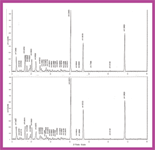
Figure 2: Powder x-ray diffractometry of ibuprofen raw material Ib (top) and the modified crystals, exemplified by Ib6 (bottom).
Density and flowability. Powder density and flowability are closely related parameters because particles that are more dense show generally better flow tendency. The determined true densities of all samples were almost the same, from 1.1112 to 1.1169 g/cm3. Ib1 and Ib2 exhibited the highest bulk density among the various powders (see Table I). The porosity and compressibility of the powders were also determined by calculating the Carr's index and Hausner's ratio (12) (see Table I). Ib4 and Ib6 exhibited better compressibility and minimal porosity and showed the smallest values for both parameters (3.75% and 1.04, respectively). On the other hand, ibuprofen exhibited correspondingly the largest values for Carr's index and Hausner's ratio (44.1% and 1.79, respectively). The modified particles exhibited far better flow characteristics as indicated by angle of repose, powder flow-rate measurements, and an evaluation of cohesion flow index by powder rheometry. This last method is a recent application of rheometry that is based on a determination of the energy required to withdraw a rotating spindle for a constant height through certain amount of powder contained in a standard cylinder. The negative sign of the index (see Table I) denotes the direction of movement of the spindle (upward in this case). Therefore, the bigger the value of the cohesion flow index, the greater the powder cohesiveness. This modern application of rheometry in estimating quantitatively the flow properties of powders is superior to traditional methods, especially for cohesive powders that exhibit inconsistent flow behavior or that completely block the orifices of measuring equipment. The values recorded demonstrate an improvement of flow, because the cohesion flow index values of Ib1–Ib6 ranged from 14 to 43, compared with a value of 104 for ibuprofen. Similar conclusions could be deduced from the angle of repose test, in which θ for the modified materials Ib1–Ib6 ranged between 36° and 40°, and θ = 54.3° for the raw ibuprofen. The powder flow rate also improved by approximately 15-fold over the control powder (e.g., 7.3 and 0.192 g/s for Ib5 and Ib, respectively) (see Table I). Improved flowability is attributed mainly to the higher bulk densities of Ib1–Ib6 (see Table I) being 0.29–0.53 g/cm3 compared with 0.29 g/cm3 for ibuprofen as well as to the bigger and more rounded particles of Ib1–Ib6 compared with the more cohesive fine crystals of ibuprofen(see Figure 1a).

Figure 3: Dissolution rate of ibuprofen raw material (Ib) in water and phosphate buffer pH 6.2 and 7.2.
Dissolution profiles. Samples from the prepared crystal agglomerates with sizes from 75 to 150 μm were used throughout the dissolution studies. Preliminary dissolution tests with phosphate buffer pH 7.2 and 6.2 as dissolution media indicated no appreciable differences of drug release from the starting ibuprofen. Drug release profiles in buffers were much faster than in distilled water (pH 6.2). Maximum drug dissolution within a short time period was attained in buffers (see Figure 3)—possibly because the soluble sodium salt of ibuprofen had formed. This result was substantiated by the slower dissolution of the drug in distilled water, which had the same pH value (pH 6.2) as one of the phosphate buffers used as a dissolution medium. Therefore, the official USP dissolution medium of ibuprofen tablets (phosphate buffer pH 7.2) was replaced in this study by distilled water to allow for better discrimination of dissolution profiles, if any, for the various forms (see Figure 4).
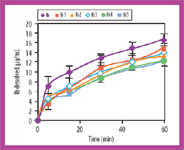
Figure 4: Dissolution rate of ibuprofen raw material (Ib) in water and the modified crystals (Ib1âIb6) in water.
The dissolution data show that ibuprofen possesses a slightly higher dissolution rate than the modified samples. These data can be explained by the larger particle-size range of the modified crystals used in the dissolution test (75–150 μm) compared with the control untreated ibuprofen (in which 90% of the particles were <55 μm), rather than a result of polymorphic changes or presence of excipients included during crystallization. Actually, the various modifications are habits, not polymorphs (based on DSC and PXRD data). In addition, the dissolution profiles cannot be attributed to the presence of excipients, which were washed out after crystallization and confirmed by an analysis of drug content in various modifications. Slight differences among the dissolution profiles of the various modifications, however, can be attributed to the crystal habits formed during crystallization in the presence of possible traces of various additives.
Wettability. The wetting tendencies of the powder samples, which were compacted into non-disintegrating disks, were tested using contact-angle methods. The observed contact angles for ibuprofen and Ib1–Ib5 were similar and ranged between 64° and 69°. The value for Ib6 was 72°, which may be partly explained by its relatively lower dissolution rate (see Figure 4) among the tested modifications.
Evaluation of powder tabletability. Tabletability of the various powder modifications was tested by evaluating the Tfactor as described in a previous report (8). This parameter involves many relevant criteria essential for tablet production, not only compressibility but also punch force, total energy, energy consumed in plastic deformation, and displacement value. Tfactor of the tested modifications increased to as much as 145 compared with 34.4 for ibuprofen (see Table III). The table also shows that the crushing strength of tablets produced from the modified powders was as high as 40 N, whereas the corresponding value of ibuprofen was only 16.4 N. Tablets prepared from the untreated raw ibuprofen showed 100% capping tendency. The corresponding tablets from the powder modifications showed lesser capping tendency, and in the case of Ib2, no capping was observed. These data indicate an appreciable improvement in tabletability of the raw material following the suggested recrystallization techniques, owing to fragmentation and better interlocking of the modified drug particles.
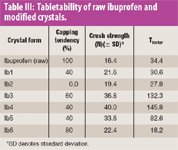
Table III: Tabletability of raw ibuprofen and modified crystals.
Conclusion
Modified crystal forms of ibuprofen with optimized processing characteristics were achieved by solvent evaporation and solvent change techniques in the presence of some additives (e.g., gelatin, Aerosil, and phosphate buffer). These methods are relatively simple and inexpensive. The modified crystals obtained were larger, rounded in appearance, noncohesive, exhibited better flow characteristics, and had higher density and compressibility compared with the common form. The resultant modifications exhibited an isomorphic nature with similar dissolution patterns. Tablets prepared from untreated raw ibuprofen showed minimal crushing strength and 100% capping tendency. In contrast, tablets prepared from the powder modifications showed higher crushing strengths and lower capping tendencies. The modified ibuprofen particles have potential application in tableting by direct compression as well as for filling in hard gelatin capsules.
Acknowledgment
This work was supported by Kuwait University (Research Grant No. PP01/02). The authors thank the Department of Pharmaceutical Technology, Kiel University for its help and for offering its facilities for the practical work. The authors are grateful to the Faculty of Science, Kuwait University, for performing the scanning electron micrographs and the powder x-ray diffraction analyses.
Aly H. Nada, PhD,* is an associate professor and chairman, Department of Pharmaceutics, Faculty of Pharmacy, Kuwait University, Kuwait, POB 24923 1130 Safat, 13110 Kuwait, tel. 1965 797 7017, fax 1965 534 2807, alynada@hsc.edu.kwSaleh M. Al-Saidan, PhD, is an associate professor at the Department of Pharmaceutics, Kuwait University. Bernd W. Mueller, PhD, is a professor and chairman of the Department of Pharmaceutical Technology & Biopharmacy, Kiel University, Germany.
*To whom all correspondence should be addressed.
References
1. P.V. Marshall, P. York, and R. Richardson, "The Effect of Compression on the Axial Recovery Properties of Compacts of a Crystalline Drug Substance," J. Pharm. Pharmacol. 38, 47P (1986).
2. N. Udupa, "Formulation and Evaluation of Polymer Films and Gels of Ibuprofen and Tinidazole," Ind. J. Hosp. Pharm. 27 (Mar.–Apr.), 77–78 (1990).
3. V. Labhasetwar, S.V. Deshmukh, and A.K. Dorle, "Studies on Some Crystalline Forms of Ibuprofen," Drug Dev. Ind. Pharm. 19 (6), 631–641 (1993).
4. G.M. Khan and Z. Jiabi, "Formulation and In Vitro Evaluation of Ibuprofen-Carbopol 974P-NF Controlled-Release Matrix Tablets, Part 3: Influence of Coexcipients on Release Rate of Drug," J. Controlled Release 54 (July 31), 185–190 (1998).
5. I. Nikolakakis, K. Kachrimanis, and S. Malamataris, "Relationship between Crystalline Conditions and Micromeritic Properties of Ibuprofen," Int. J. Pharm. 201 (1), 79–88 (2000).
6. H.A.Garekani et al., "Crystal Habit Modifications of Ibuprofen and their Physicomechanical Characteristics," Drug Dev. Ind. Pharm. 27 (8), 803–809 (2001).
7. N. Rasenack and B.W. Mueller, "Properties of Ibuprofen Crystallized under Various Conditions: A Comparative Study," Drug Dev. Ind. Pharm. 28 (9), 1077–1089 (2002).
8. N. Rasenack and B.W. Mueller, "Crystal Habit and Tableting Behavior," Int. J. Pharm. 244 (1–2), 45–57 (2002).
9. N. Rasenack and B.W. Mueller, "Ibuprofen Crystals with Optimized Properties," Int. J. Pharm. 245 (1–2), 9–24 (2004).
10. K. Kachrimanis, G. Ktistis, and S. Malamataris, "Crystallization Conditions and Physicomechanical Properties of Ibuprofen-Eudragit S100 Spherical Crystal Agglomerates Prepared by the Solvent Change Technique," Int. J. Pharm. 173 (Oct. 30), 61–74 (1998).
11. J.D. Higgins et al., "Ibuprofen," in Analytical Profiles of Drug Substances and Excipients, H.G. Brittain, Ed. (Academic Press, San Diego, CA, 27th ed., 2001), pp. 265–300.
12. J. Wells, "Pharmaceutical Preformulation: The Physicochemical Properties of Drug Substances" in Pharmaceutics: The Science of Dosage Form Design, M.E. Aulton, Ed. (Churchill Livingstone, Harcourt Publisher, London, 2d ed., 2002), pp. 133–135.
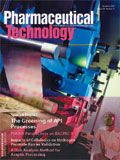
Drug Solutions Podcast: A Closer Look at mRNA in Oncology and Vaccines
April 30th 2024In this episode fo the Drug Solutions Podcast, etherna’s vice-president of Technology and Innovation, Stefaan De Koker, discusses the merits and challenges of using mRNA as the foundation for therapeutics in oncology as well as for vaccines.